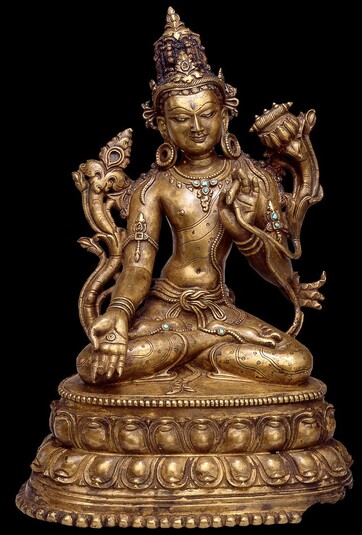
Item: Manjushri (Bodhisattva & Buddhist Deity) - White (Siddhaikavira)
| Origin Location | Tibet |
|---|---|
| Date Range | 1200 - 1299 |
| Lineages | Buddhist |
| Size | 31.45cm (12.38in) high |
| Material | Metal, Painted Face/Hair, Precious Stone, Stone Inset: Turquoise |
| Collection | Asia Society |
| Catalogue # | acc. #1979.046, Mr. and Mrs. John D. Rockefeller 3rd Collection of Asian Art |
Classification: Deity
Appearance: Peaceful
Gender: Male
Manjushri, Sita (Tibetan: jam pal kar po. English: the White One of Glorious Melodious Speech), the bodhisattva of wisdom as a meditational deity, from the Siddhaikavira Mahatantraraja [Toh 544]. Although there are a number of different forms of Manjushri that have a white appearance generally when referring to a white Manjushri it refers to either the popular Siddhaikavira or the Arapachana - not to be confused with the orange Arapachana. (See the Palpung composition with a blue upper garment).
Sanskrit: Manjushri Tibetan: Jam pal yang
Tibetan: Jam pal yang
"...from...an ocean of nectar, white and cool, with many elephants, geese and water fowl sporting and playing, calling out with sweet sounds, in the middle of that...[arises] a lotus with a stem, branches, leaves, fruit and a marvelous sweet fragrance. Above [arises] a moon disc seat with cool rays of light shining forth to the ten directions. Again [the light] collects ... and from this collection ... is Manjushri; white like the autumn moon, a boy of eight years with a youthful form, having five knots [of hair]. The right hand is in the mudra of supreme generosity. The left holds a blue lotus to the heart, blossoming at the left shoulder and marked with the Prajnaparamita book. Seated firmly with the feet in vajra posture, with the major marks and blazing with light, adorned with various jewel ornaments and wearing white silks." (Mati Tradition, Rinchen Gyaltsen, 15th century).
The Siddhaikavira (Solitary Hero) Tantra was first translated into Tibetan in the 11th century at the time of Lord Atisha and is classified as a Kriya or Charya Tantra. It describes numerous forms of Manjushri along with a host of other deities both peaceful and wrathful: Sarasvati, Jambhala, Vasudhara, Achala, etc.
Confusions in Identification with Other Deities: - White Tara - Padmapani - Others...
Jeff Watt 9-2002 [updated 3-2017]
Sculpture: Monastic Period (Peaceful Deity Figures)
Sculpture: Western Tibetan
Buddhist Deity: Manjushri Main Page
Subject: Wisdom Increasing Deities Main Page
Collection of Asia Society, New York
Buddhist Deity: Manjushri, White, Main Page
Buddhist Deity: Manjushri Sculpture Page
Buddhist Deity: Manjushri, Arapachana (Various Forms)
Buddhist Deity: Manjushri (Sculpture Masterworks)
Buddhist Deity: Manjushri, White (Masterworks)
Buddhist Deity: Manjushri, White (Siddhaikavira Tantra)
Sculpture: Monastic Period (Tibet, 13-14th century)
Sculpture: Monastic Period (Masterworks)
Sculpture: Size of Objects
Essay: Manjushri, Similarities & Differences
